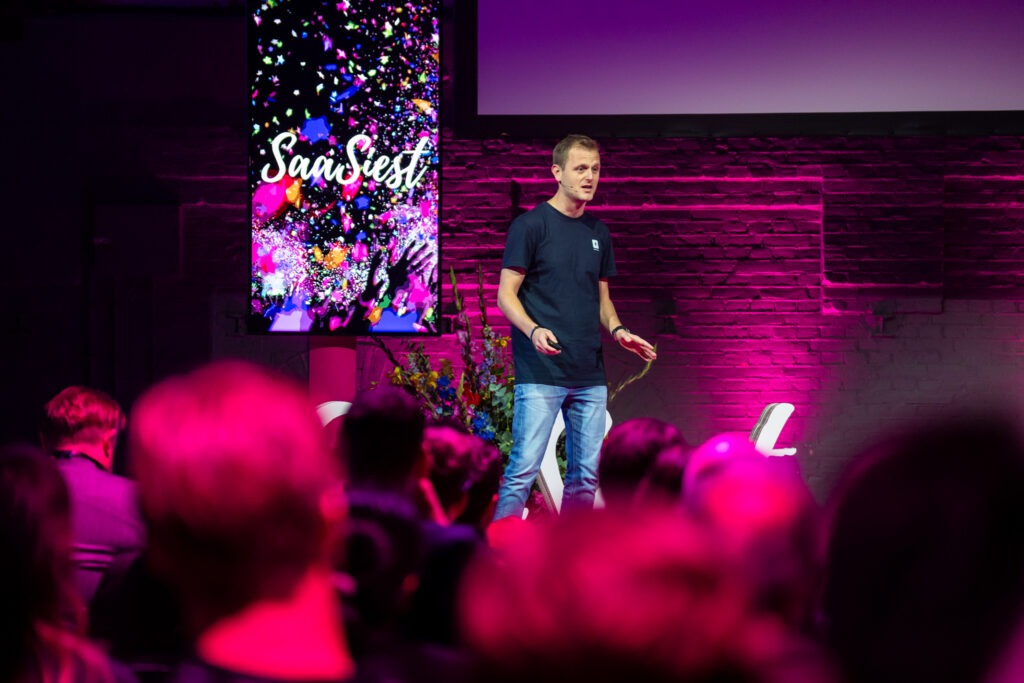
AI is dominating headlines and boardroom discussions. But according to Rick van Esch, CEO and co-founder of Structured AI, the conversation is often more talk than action. With a unique background spanning finance, SaaS, and AI, Rick is on a mission to merge these worlds, delivering investment insights for finance professionals through advanced language models. In a recent session at SaaSiest Amsterdam, he shared valuable insights into AI’s current capabilities, the challenges ahead, and how we can all embrace the AI revolution strategically.
Riding the AI wave
Rick’s take on the current state of AI is simple yet sobering: if you don’t have an AI strategy today, you risk becoming irrelevant in just a few years. As he explains, we are at the early stages of an innovation wave, not unlike those of the past that changed industries forever. Yet, despite high expectations, real productivity from AI still lags behind the hype—a natural occurrence in any innovation cycle. Companies must invest now to be prepared for when AI reaches the plateau of productivity.
Where AI excels and struggles
Rick believes AI is outperforming humans in various domains, even passing rigorous professional benchmarks like the bar exam. OpenAI’s GPT-4, for example, outperformed 90% of law students in exam scenarios. But AI isn’t perfect. It struggles with visual common-sense reasoning, the kind that allows humans to understand cause and effect. AI can tag images and interpret simple patterns, but something as nuanced as understanding why a child is crying in a photo still eludes its grasp.
What’s next for AI?
Predicting the future is no easy task, but Rick laid out some compelling expectations for the next year:
- Breakthroughs in visual common-sense reasoning: Advances in understanding cause and effect will transform what AI can do.
- Slow progress in video generation: Although tools like Runway are impressive, we’re not quite ready for AI-generated Hollywood blockbusters.
- Language model limitations: AI still struggles with interpretation, just as humans can misunderstand instructions. This limitation will persist, creating challenges for companies.
- The rise of multimodal AI: Expect breakthroughs in models that handle multiple input types, like speech and text, making technology even more accessible to non-coders.
Building AI solutions: 4 lessons learned
For companies aiming to develop AI-powered products, Rick offered some valuable do’s and don’ts:
- Start with the user problem: Many AI initiatives fail because they’re technology-driven rather than user-centric. Rick learned this lesson firsthand when his company created a feature to auto-title workflows. Despite the clever idea, clients found it frustrating when titles didn’t match their needs. “Always think about what your users will find valuable,” Rick emphasized.
- Avoid the one-size-fits-all approach: Different users have different needs. Not all AI solutions should be generically applied. Tools and models should be chosen wisely, aligning with the specific problems they’re meant to solve.
- Focus on explainability: Transparency is crucial, especially for professionals like lawyers and CFOs who need to understand AI outputs. Showing the source of data builds trust. Companies should prioritize making AI’s decision-making processes visible and comprehensible.
- Don’t underestimate costs: Building and fine-tuning AI models is expensive. Computational costs can surprise companies, especially if customer demand suddenly spikes. Additionally, the latest AI models may not always be available in all regions, such as the EU.
The Future of AI compute Power
AI development isn’t just about algorithms; it’s heavily influenced by compute power. Currently, most AI discussions focus on GPUs. However, Rick foresees a shift towards NPUs, originally developed for wearable devices. These specialized chips are becoming increasingly essential for training large language models, offering faster and more efficient processing.
Rick doesn’t sugarcoat the realities of AI development but believes in human-AI collaboration. He highlighted Microsoft’s choice to call their tool “Co-Pilot” instead of “Pilot,” emphasizing that AI should augment human capabilities, not replace them. European regulations, such as the AI Act, also stress that AI must keep humans in the loop for critical decisions.
The “feeling economy” and human value
While AI might excel at analytical tasks, Rick believes our future lies in the “feeling economy.” As AI takes over more cognitive labor, human skills like empathy and emotional intelligence will become even more valuable. The jobs of the future, especially in sectors like healthcare and management, will be defined by our ability to feel, connect, and care. This shift could even narrow gender gaps in the workforce, as empathy-driven roles grow in importance.
Despite concerns, Rick is optimistic. He believes AI will free us from mundane analytical tasks, allowing us to focus more on what makes us uniquely human: our emotions and connections. “AI will ultimately make us more human again,” he said. “We’ll have more time for empathy, creativity, and meaningful interactions.”
AI might be reshaping the world, but if approached thoughtfully, it’s an opportunity to become better at what only humans can do. The key? Invest in AI wisely, keep humans at the center, and be ready for an exciting, empathy-driven future.